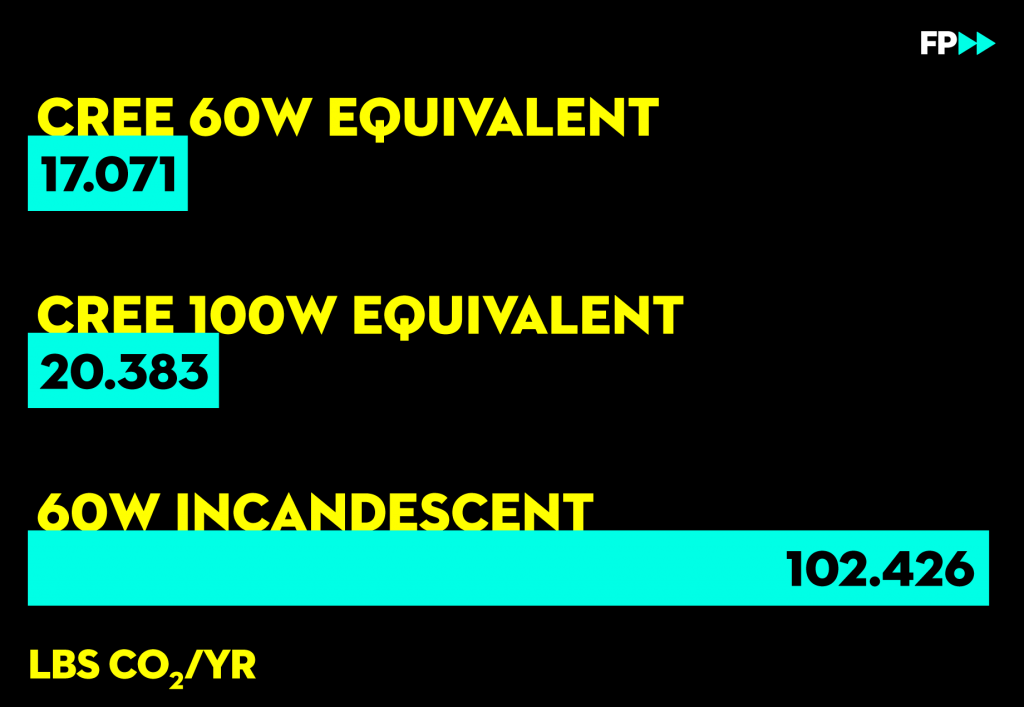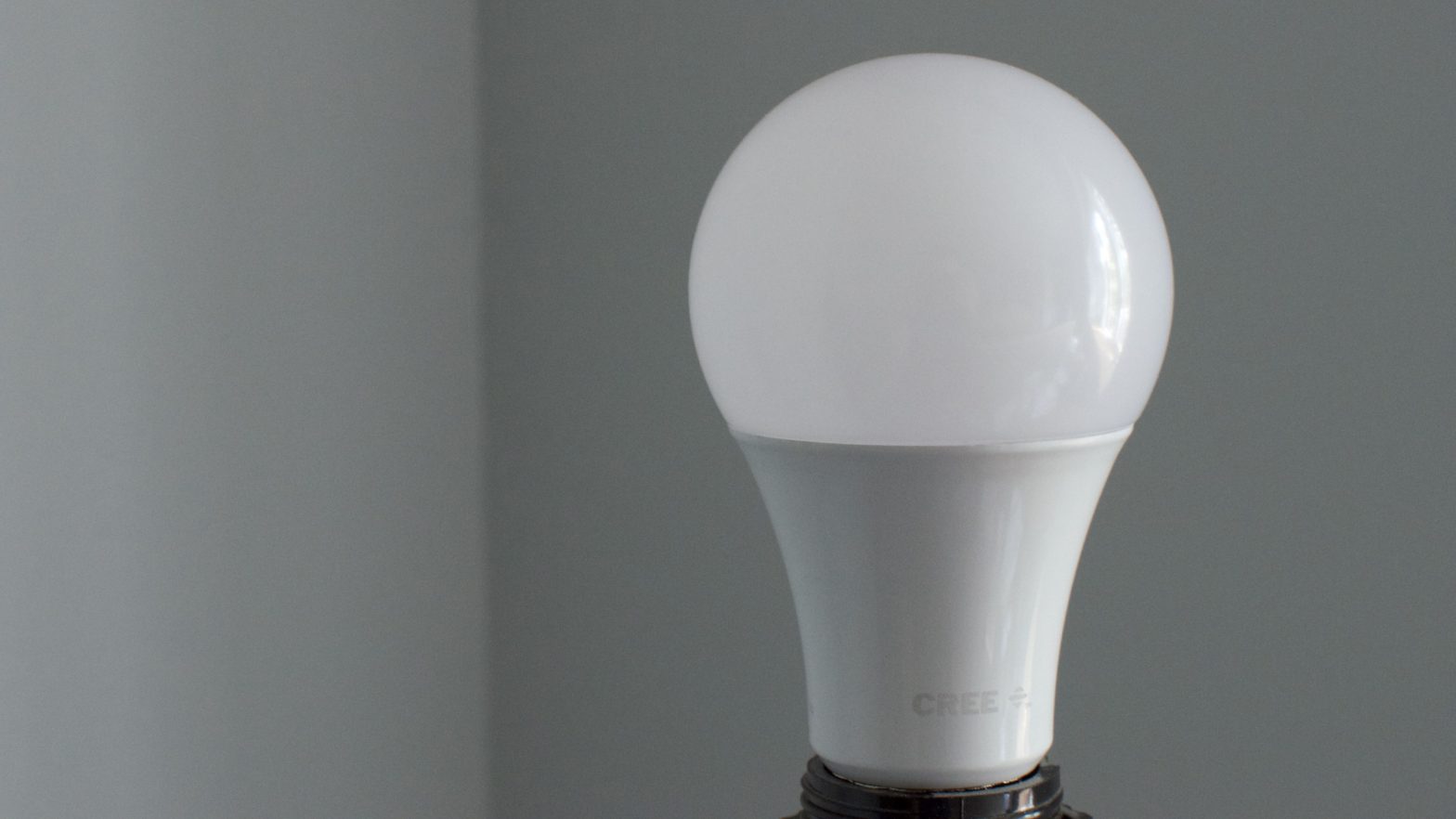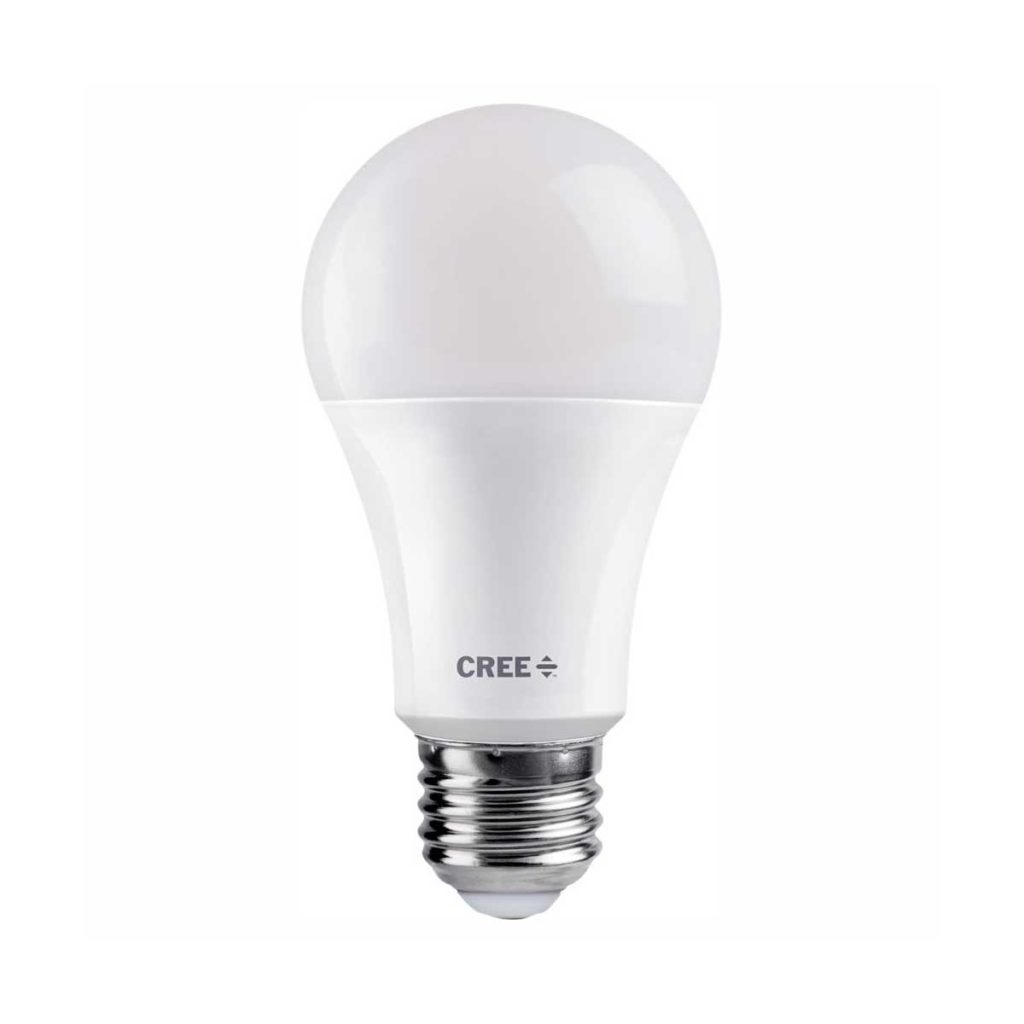To reduce your electric bill, we recommend the Cree 60W Equivalent Soft White A19 Dimmable light bulb. It’s bright and efficient, and it casts a light that’s very similar to your old incandescents.
Update: We’ve recently reviewed our recommendations and removed the Soraa Radiant, which is no longer available and scheduled to be replaced with a new model in the coming months. We still like our other top picks, and we think you will, too.
Cree 60W Equivalent Soft White A19 Dimmable
Simple and bright, this LED bulb produces light that’s remarkably like benchmark incandescents.
The Cree 60W Equivalent A19 Dimmable is a pleasing, versatile, and inexpensive light bulb that uses very little energy compared with old incandescent bulbs. Its light quality is excellent, and its warranty is unparalleled. If you use your lights three or more hours per day, it will pay for itself in less than a year.
Cree 100W Equivalent Soft-White A21 Dimmable
A truly bright light that pumps out more than enough lumens to replace your wasteful old 100 W light bulbs.
Like the Cree 60W Equivalent light bulb, the Cree 100W Equivalent Soft-White A21 Dimmable is easy on the eye, producing light that all but matches old incandescents at a fraction of the energy use. At 1,600 lumens, its incredibly bright. The only caveat is it is slightly bigger than most standard bulbs, so it won’t fit in some fixtures.
Why these are the most climate-friendly LED light bulbs
LED light bulbs are far and away more efficient than the incandescents they replace. They typically use around 80–85% less electricity, meaning a 60 W equivalent uses around 9–11 W and a 100 W equivalent around 15–18 W. When you start counting the number of light bulbs in your home, you can see how replacing incandescents (or even CFLs) with LEDs can start quickly making a difference.

Methods and Results
- Why trust us
- Who should get this
- How we decided
- How we tested
- Best for most people: Cree 60W Equivalent Soft White A19 Dimmable
- Brighter light: Cree 100W Equivalent Soft White A21 Dimmable
- The competition
- What else we discovered
- Sources
Why trust us
As part of a fellowship I was awarded at MIT, I studied lighting in their architecture program. For this review, I spent nearly two days researching the wide variety of LED light bulbs that are available, and I tested the top three in my home. I also interviewed Nadarajah Narendran, the director of research at Rensselaer Polytechnic Institute’s Lighting Research Center.
Who should get this
We all have to buy light bulbs at some point in our lives, and opting for LED light bulbs is a great way to slash your electricity bill.
Energy efficient lighting has been around for a while, but it has vastly improved over the last few years. LEDs have largely solved the problems that plagued compact fluorescents, the first wave of energy efficient light bulbs. Today’s LED light bulbs are dimmable, turn on instantly and to full brightness, and can produce high-quality light.
“With LEDs, energy efficiency is a given,” said Nadarajah Narendran, director of research at Rensselaer Polytechnic Institute’s Lighting Research Center. Most LEDs use between 80–85% less electricity than comparable incandescent light bulbs and 30% less than CFLs. “Incandescents are very efficient at converting electric energy to radiant energy—but they mostly produce more energy in the infrared range” which creates heat, not light, he said. “That’s what makes them such bad light bulbs. Incandescents only convert 5% or so [of the electricity] into light.” LED light bulbs are more efficient, producing less heat. That helps them last longer and work in a wider variety of fixtures.
Still, as of two years ago, less than 30% of U.S. households used LED light bulbs. Switching a light bulb from incandescent to LED can pay back in less than a year—including the cost of the bulb (assuming the bulb is on about three hours per day). After that, it’s all savings on your electricity bill.
How we decided
When tested our top picks, we considered the following criteria.
Light quality: Quality of light was a top consideration for each LED light bulb we tested. Old LED light bulbs often cast an overly yellowish light, causing colors to look hazy, washed out, or yellow-tinged. A good LED light bulb should let colors pop without looking garish.
Certain aspects of light quality are in the eye of the beholder. Some people prefer a warmer tone creates a reddish or yellowish white, while others prefer a cooler, bluer light.
But there is an objective measure of light quality known as color rendering index (CRI). Light bulbs are ranked on a scale of zero to 100. Incandescents score 100, while CFLs rate in the low 60s and lower-quality LED light bulbs come in at around 80. Higher-quality LEDs score 90 or above.
Energy use: Energy efficiency is one of the main reasons people buy LED light bulbs, but not all LEDs are created equal. Some produce more light for a given wattage. “Most of the 60W incandescents can be replaced with 8W lamp,” Narendran said. “An 8W lamp should have about 800 or so lumens. If that’s there, then you know you’ll get light at the right level and the energy consumption will be low.”
Dimming: A high-quality LED light bulb should dim without buzzing for flickering. It should also maintain its ability to render colors accurately, and ideally it should dim continuously down to 1% before turning off.
How we tested
We spent over a day and a half researching over two-dozen LED light bulbs, and we purchased our three top contenders and tested them in our home over the course of four weeks. During that time, we were looking for anything that would be out of the ordinary for a high-quality LED light bulb—things like buzzing, flickering, or delays in turning on. We also graded them on light quality. Did we notice the difference between the new bulbs and our existing LEDs and CFLs? How did they compare with a reference incandescent bulb?
We also tested each top pick for unexpected dimming. LED light bulbs are, at their core, electronics. Electronics generate heat, and if that heat isn’t sufficiently shed, their performance will suffer. To test this, we installed each LED light bulb in a hanging fixture in a darkened room and placed an illuminance meter 15” directly under the bulb. We measured illuminance first after turning on the light bulb and again after 30 minutes.
(Note: Our ratings for light output will differ intentionally from those on the box. That’s because we measured the light at a fixed point directly below the hanging bulb. It’s a measurement known as illuminance and is reported in lux. Manufacturers have different testing environments and measure the light cast in all directions. This measurement is known as luminous flux and is reported in lumens.)
Cree 60W Equivalent Soft White A19 Dimmable
Simple and bright, this LED bulb produces light that’s remarkably like benchmark incandescents.
Why we like it
The Cree 60W Equivalent A19 Dimmable is a great LED light bulb. It’s simple, inexpensive, and efficient, and it produces light that’s closer to incandescents than many other bulbs.
There are LED light bulbs that are a little less expensive—often less than a dollar per bulb cheaper—but the added cost of the Cree is worth it. For one, you get better light. The Cree 60W Equivalent A19 Dimmable we tested has a CRI over 90, whereas cheaper bulbs tend to have a CRI of 80. That may not seem like much, but when we tested them in our home, the difference was obvious. A bulb with a CRI of 80 made our family room look hazy by comparison.
Cree also offers a variety of different brightnesses, from 40W to 100W equivalent bulbs (460 to 1600 lumens). They even sell a three-way bulb if you’re looking to replace an incandescent in a compatible lamp. All of these light bulbs come in the familiar “A” shape. (Though we should point out that the 100W equivalent is slightly bigger than the rest—it’s an A21 bulb vs. A19—which means it won’t fit in certain fixtures.)
Each Cree A-series light bulb comes with a ten-year warranty. It’s an impressive warranty for an inexpensive LED light bulb and longer than the competition.
Why you can feel good about it
Like other LED light bulbs, the Cree 60W Equivalent is much more efficient at converting electricity to visible light. In a year of typical use (three hours per day), it produces just 17 pounds of CO2. That’s 84% lower than a 60W incandescent.
The packaging has a relatively light footprint, too. Cree A19 bulbs are packed in cardboard boxes with simple cardboard inserts. There appears to be a plastic coating on the outside box, but otherwise the whole thing should be easily recyclable.
Who else likes it
The Cree 60W Equivalent A19 Dimmable light bulb is well regarded by a number of reviewers. CNET’s Ry Crist said, “If you just need a light bulb and don’t want to think about it too much, Cree’s new LED is a safe, smart pick.” Over at The Wirecutter, Anna Perling said the Cree bulbs “performed better than any other bulbs in our tests.” They’re highly rated by regular people, too, with a rating at Home Depot at the time of publication of 4.5 across 588 reviews, and 78% said they would recommend it to others.
What could be improved
All LED light bulbs will dim a little bit after being on for a while, but the Cree 60W Equivalent dimmed the most of any light in this test (and of any LED light we’ve tested). Its illuminance dropped 11% over 30 minutes. That’s probably not going to be noticeable, but it’s still more than we’d like to see. Such substantial dimming is probably due to heat build-up inside the bulb. In other LEDs where heat matters more—like smart light bulbs—you can see significantly less dimming.

The other thing we’d change is the packaging. It appears to be plastic coated—likely to help it stand out on store shelves—but if you’re ordering it from the internet, it’s unnecessary and makes recycling a little bit harder, and it’s not recommended for composting.
Cree 100W Equivalent Soft-White A21 Dimmable
A truly bright light that pumps out more than enough lumens to replace your wasteful old 100 W light bulbs.
Why we like it
The Cree 100W Equivalent Soft-White A21 Dimmable replicates the experience of it’s smaller, slightly dimmer sibling reviewed above and nearly doubles the lumens without doubling the power draw. It produces great quality light, with a CRI above 90 and has the same 10-year warranty. If you need more light in your room, this is the bulb to get.
Why you can feel good about it
Though it produces enough lumens to replace a 100 W incandescent bulb, the Cree 100W Equivalent uses 83% less electricity. Over the course of a year, it’s carbon footprint is just 20.83 pounds, 150 pounds less than a 100 W incandescent bulb.
Cree’s packaging is all cardboard, so it should be easily recyclable.
What could be improved
It’s bigger than most regular light bulbs, and that limits what fixtures you can put it in. It’s considered an A21 bulb, which means it’s 0.6 inches longer and 0.35 inches bigger in diameter. That may not sound like much, but it prevents it from being installed in a variety of enclosed fixtures like those commonly found in bedrooms. It’s likely by design—bulbs in enclosed fixtures can suffer from catastrophic failure due to excess heat (see below), and a brighter light is going to generate more heat. In fact, most 100 W equivalent LEDs are A21 bulbs, so Cree is not alone here.
Like the other bulbs in this test. the Cree 100W Equivalent dimmed after being on for 30 minutes, though at 8%, it was less than the others. That’s likely due to slightly better thermal management inside the larger bulb.
The competition
We didn’t cover specialty bulbs here, but if you have a Hollywood-style bathroom mirror or a clear glass chandelier, consider Feit’s decorative LED light bulbs. They come in a range of shapes and sizes, from candelabras to “vintage” bulbs with convincing faux filaments. We have four of the latter in our dining room, and they look great. We also like their unobtrusive labels. Other decorative bulbs have more prominent labels that are easily visible when the lights are off. In our experience, the only mark against the Feit decorative bulbs is that they don’t dim continuously to zero.
If you need more than 800 lumens but still need a smaller light, check out the Philips 100-Watt Equivalent A19. It has a shorter rated life than our 100 W pick, it doesn’t produce quite as much light (1,500 vs 1,600 lumens), has a lower CRI (80 vs 90), and isn’t rated for enclosed fixtures. But it will fit the bill if you need a smaller bulb to clear a lampshade, for example.
Amazon offers their own private label LED light bulbs under the AmazonBasics name, and they are pretty inexpensive when purchased in bulk. However, they only have a three-year warranty. Their specs don’t list a color rendering index, nor are they Energy Star rated, which suggests the light quality may not be that great. For about the same price, our top pick will likely do a much better job.
GE also makes a range of LED light bulbs—almost too many—and The Wirecutter didn’t like the light quality they produced. Feit Electric also makes LEDs in the usual bulb shape that are highly rated on Home Depot, but The Wirecutter says they flickered when dimmed—an automatic disqualified for consideration here at Future Proof.
What else we discovered
LEDs can have fantastically long lives—15,000, 25,000, even 50,000 hours. At three hours per day, an LED could theoretically last up to 45 years. It could be the last light bulb you ever buy.
And in some cases, that may be true. LED light bulbs in open fixtures—like a table or floor lamp—could very well meet their expected lifespan. But in enclosed fixtures, the may die well before then.
The industry standard says that an LED “dies” when its light output drops below 70% of its rating. In other words, when an 800-lumen bulb produces less than 560 lumens, it’s “dead.” It will probably keep shining after that, but 70% is when people start to notice. Lighting experts call this parametric failure.
There’s another type known as catastrophic failure. It’s analogous to how incandescents died—with a sudden pop. In LED light bulbs, catastrophic failures occur when components other than the LEDs fail. The most common is when a piece of solder breaks, disrupting the electric current. Another is the death of the driver, the part that converts alternating current from the socket to the required direct current.
Catastrophic failure can occur in any bulb, but it happens most often when LED light bulbs are in enclosed fixtures like a ceiling light. “Especially if you put these light bulbs into fixtures like ceiling-mounted fixtures, they will fail in 1,000 to 5,000 hours,” depending on how many bulbs are in the lamp, Narendran said. “When you switch these lamps on and off, they undergo thermal stress.” The rapid change in temperature causes the components to expand and contract, stressing the solder joints and pulling them apart.
Notes
We calculate carbon footprint of energy use according to the most recent data from the U.S. Environmental Protection Agency. Their models say that every kWh of electricity produces 1.559 pounds of CO2.
Sources
- Crist, Ry. “Cree 60W Replacement LED (2018) review,” CNET. June 26, 2018.
- Narendran, Nadarajah. Phone interview. May 3, 2019.
- Perling, Anna. “The Best LED Light Bulb,” The Wirecutter. February 20, 2019.



